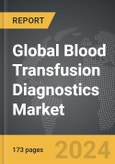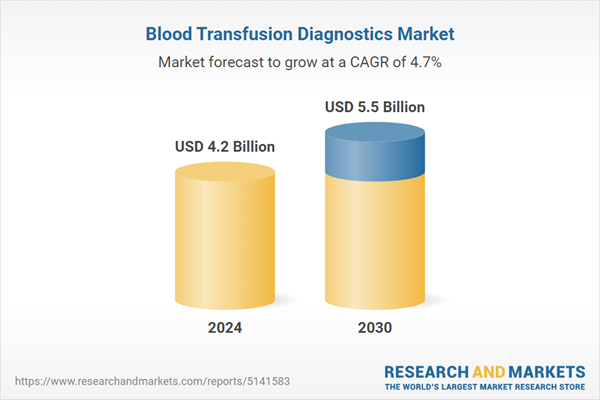Global Blood Transfusion Diagnostics Market - Key Trends & Drivers Summarized
Why Is Blood Transfusion Diagnostics Gaining Importance in Healthcare?
Blood transfusion diagnostics are critical to ensuring the safety and effectiveness of blood transfusions, a procedure that saves millions of lives annually. With rising incidences of trauma, surgeries, and chronic diseases, the demand for blood transfusions continues to grow, driving the need for reliable diagnostics to prevent transfusion-related complications. Blood transfusion diagnostics involve rigorous testing of blood samples to ensure compatibility and screen for infectious diseases like HIV, hepatitis, and malaria. As the demand for safe transfusions increases globally, particularly in regions with high rates of trauma and surgery, these diagnostic technologies are becoming essential in healthcare systems worldwide.How Are Technological Innovations Shaping the Future of Blood Transfusion Diagnostics?
Technological innovations are playing a key role in advancing blood transfusion diagnostics, improving both accuracy and efficiency. Automated blood screening technologies have streamlined the testing process, reducing human error and speeding up diagnosis times. The use of nucleic acid amplification tests (NAT) has significantly improved the sensitivity of infectious disease screening, enabling earlier detection of blood-borne pathogens. Moreover, innovations in molecular diagnostics and serology have enhanced the precision of blood typing and compatibility testing, minimizing the risks associated with transfusions. The integration of AI in transfusion diagnostics is also emerging, with machine learning algorithms enhancing predictive capabilities for identifying rare blood types and antibodies.What Challenges Does the Blood Transfusion Diagnostics Market Face?
Despite the advancements, the blood transfusion diagnostics market faces several challenges, including regulatory hurdles, high costs, and the need for advanced infrastructure. Strict regulations governing the safety and efficacy of diagnostic tests, particularly in developed countries, can delay the approval and market entry of new technologies. Additionally, the cost of implementing advanced blood screening technologies can be prohibitive for hospitals and clinics, particularly in low-resource settings. In regions with limited access to diagnostic infrastructure, the lack of automation and skilled professionals can hinder the adoption of modern transfusion diagnostics. However, initiatives to strengthen healthcare systems and expand access to diagnostic services in these regions are slowly mitigating these barriers.The Growth in the Blood Transfusion Diagnostics Market Is Driven by Several Factors
The growth in the blood transfusion diagnostics market is driven by several factors, including the increasing need for safe blood transfusions, technological innovations, and rising demand in emerging markets. The growing number of surgeries, trauma cases, and treatments for conditions such as cancer and blood disorders contribute to the heightened demand for accurate blood testing. Technological advancements, such as automated testing platforms and molecular diagnostics, are making the screening process faster and more reliable, further boosting market growth. Emerging economies are witnessing an increase in healthcare spending and infrastructure development, creating opportunities for the expansion of blood transfusion diagnostics. Furthermore, government initiatives and awareness campaigns promoting safe transfusion practices are also helping to drive the market forward.Report Scope
The report analyzes the Blood Transfusion Diagnostics market, presented in terms of market value (US$ Thousand). The analysis covers the key segments and geographic regions outlined below.- Segments: Application (Blood Grouping, Disease Screening); End-Use (Hospitals, Blood Banks, Diagnostic Laboratories, Plasma Fractionation Companies); Product Type (Instruments, Kits & Reagents).
- Geographic Regions/Countries:World; United States; Canada; Japan; China; Europe (France; Germany; Italy; United Kingdom; Spain; Russia; and Rest of Europe); Asia-Pacific (Australia; India; South Korea; and Rest of Asia-Pacific); Latin America (Argentina; Brazil; Mexico; and Rest of Latin America); Middle East (Iran; Israel; Saudi Arabia; United Arab Emirates; and Rest of Middle East); and Africa.
Key Insights:
- Market Growth: Understand the significant growth trajectory of the Instruments segment, which is expected to reach US$1.7 Billion by 2030 with a CAGR of a 4.4%. The Kits & Reagents segment is also set to grow at 4.9% CAGR over the analysis period.
- Regional Analysis: Gain insights into the U.S. market, valued at $1.1 Billion in 2024, and China, forecasted to grow at an impressive 7.1% CAGR to reach $1.2 Billion by 2030. Discover growth trends in other key regions, including Japan, Canada, Germany, and the Asia-Pacific.
Why You Should Buy This Report:
- Detailed Market Analysis: Access a thorough analysis of the Global Blood Transfusion Diagnostics Market, covering all major geographic regions and market segments.
- Competitive Insights: Get an overview of the competitive landscape, including the market presence of major players across different geographies.
- Future Trends and Drivers: Understand the key trends and drivers shaping the future of the Global Blood Transfusion Diagnostics Market.
- Actionable Insights: Benefit from actionable insights that can help you identify new revenue opportunities and make strategic business decisions.
Key Questions Answered:
- How is the Global Blood Transfusion Diagnostics Market expected to evolve by 2030?
- What are the main drivers and restraints affecting the market?
- Which market segments will grow the most over the forecast period?
- How will market shares for different regions and segments change by 2030?
- Who are the leading players in the market, and what are their prospects?
Report Features:
- Comprehensive Market Data: Independent analysis of annual sales and market forecasts in US$ Million from 2024 to 2030.
- In-Depth Regional Analysis: Detailed insights into key markets, including the U.S., China, Japan, Canada, Europe, Asia-Pacific, Latin America, Middle East, and Africa.
- Company Profiles: Coverage of players such as Abbott Laboratories, Bag Health Care GmbH, Bio-Rad Laboratories, Inc., DiaSorin SpA, F. Hoffmann-La Roche AG and more.
- Complimentary Updates: Receive free report updates for one year to keep you informed of the latest market developments.
Some of the 42 companies featured in this Blood Transfusion Diagnostics market report include:
- Abbott Laboratories
- Bag Health Care GmbH
- Bio-Rad Laboratories, Inc.
- DiaSorin SpA
- F. Hoffmann-La Roche AG
- Grifols International SA
- Hologic, Inc.
- Immucor, Inc.
- Ortho Clinical Diagnostics, Inc.
- Quotient Ltd.
This edition integrates the latest global trade and economic shifts into comprehensive market analysis. Key updates include:
- Tariff and Trade Impact: Insights into global tariff negotiations across 180+ countries, with analysis of supply chain turbulence, sourcing disruptions, and geographic realignment. Special focus on 2025 as a pivotal year for trade tensions, including updated perspectives on the Trump-era tariffs.
- Adjusted Forecasts and Analytics: Revised global and regional market forecasts through 2030, incorporating tariff effects, economic uncertainty, and structural changes in globalization. Includes historical analysis from 2015 to 2023.
- Strategic Market Dynamics: Evaluation of revised market prospects, regional outlooks, and key economic indicators such as population and urbanization trends.
- Innovation & Technology Trends: Latest developments in product and process innovation, emerging technologies, and key industry drivers shaping the competitive landscape.
- Competitive Intelligence: Updated global market share estimates for 2025, competitive positioning of major players (Strong/Active/Niche/Trivial), and refined focus on leading global brands and core players.
- Expert Insight & Commentary: Strategic analysis from economists, trade experts, and domain specialists to contextualize market shifts and identify emerging opportunities.
Table of Contents
Companies Mentioned (Partial List)
A selection of companies mentioned in this report includes, but is not limited to:
- Abbott Laboratories
- Bag Health Care GmbH
- Bio-Rad Laboratories, Inc.
- DiaSorin SpA
- F. Hoffmann-La Roche AG
- Grifols International SA
- Hologic, Inc.
- Immucor, Inc.
- Ortho Clinical Diagnostics, Inc.
- Quotient Ltd.
Table Information
| Report Attribute | Details |
|---|---|
| No. of Pages | 173 |
| Published | December 2025 |
| Forecast Period | 2024 - 2030 |
| Estimated Market Value ( USD | $ 4.2 Billion |
| Forecasted Market Value ( USD | $ 5.5 Billion |
| Compound Annual Growth Rate | 4.7% |
| Regions Covered | Global |









